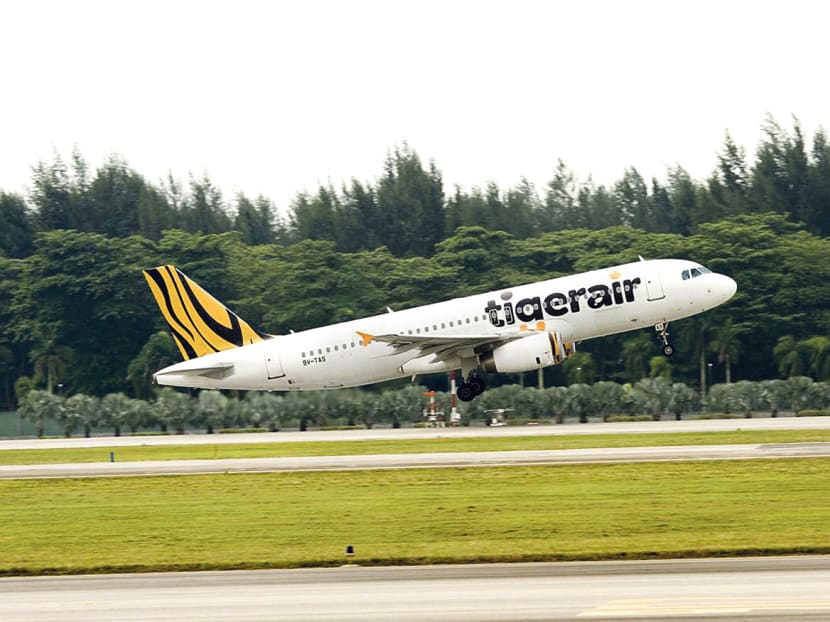Tigerair unveils turnaround plans amid heavy losses, tight competition

Over the past three years, Tigerair’s report card has mostly been in the red. Revenue fell 10 per cent to S$146.7 million in the second quarter. PHOTO: Tigerair
SINGAPORE — Tiger Airways has stepped up its turnaround plans amid heavy losses and stiff competition, as it announced yesterday that largest shareholder Singapore Airlines (SIA) will raise its stake in the budget airline and Virgin Australia will buy out its unprofitable joint venture Down Under.
The announcement came as the Singapore budget airline posted a net loss at S$182.4 million in its fiscal second quarter ended September, widening from a loss of S$65.2 million in the first quarter and reversing from a net profit of S$23.8 million a year earlier.
Over the past three years, Tigerair’s report card has mostly been in the red. Revenue fell 10 per cent to S$146.7 million in the second quarter.
Despite the plans, investors of Tigerair were not assured and the counter fell as much as 11 per cent to a record low of 29 cents in early trading yesterday before ending down 4.6 per cent to 31 cents at the market close.
Analysts said many budget carriers are struggling to cope with excess capacity and low fares that are unsustainable for their bottomline and that Tigerair is expected to continue facing these headwinds for some time.
Tigerair said it will sell its remaining 40 per cent stake in its Australian venture to Virgin Australia for a nominal sum of A$1.
It has recorded a S$59.8 million charge due to the divestment and will still obtain franchise revenues.
Analysts have questioned the rationale of Tigerair entering the tough Australian market in the first place.
Mr Timothy Ross, head of Transport Research, Asia-Pacific, at Credit Suisse, said: “The operating environment in Australia is tougher than it had imagined. Clearly, the market is not growing as expected.”
UOB Kay Hian analyst Mr K. Ajith agreed, saying: “The offshore operations in Australia have been in the red for quite a while given Australia’s matured market. Tigerair should focus instead on faster-growing markets elsewhere.”
As part of the plan to turn around its ailing business, Tigerair said yesterday that SIA will raise its stake in the budget carrier to about 55 per cent from 40 per cent by undertaking a securities conversion into shares.
Tigerair also plans to raise up to S$234 million through a rights issue of 1.2 billion new shares at a price of 20 cents per rights share, with SIA subscribing up to S$140 million.
SIA’s stake will rise further after the rights issue, which is expected to be completed in January. But some analysts were puzzled by the move, with Credit Suisse’s Mr Ross saying that “there is a big hole in the sky and SIA is pouring money into it”.
An analyst at a bank, who declined to be named as he was not allowed to speak to the media, said he understood from the SIA management that the flag carrier still wants to have a short-haul budget airline in its portfolio. Even as Tigerair winds down its involvement in Australia and elsewhere, it is partnering SIA’s long-haul budget airline Scoot to expand in markets such as Taiwan and Thailand.
Lee Lik Hsin, group chief executive officer of Tigerair, said yesterday: “We are already working closely with Scoot and look forward to further collaboration with the rest of the SIA Group.”
In June, Tigerair shut down its loss-making Indonesian venture Tigerair Mandala. It also terminated flights to Trivandrum city in India last month and has reduced a number of flights to various destinations over the past few months. Mr Lee said: “We resolved our excess capacity issues through the sublease arrangements made for the surplus aircraft and we also stemmed further losses from our overseas venture.”
Mr Ross said that Tigerair’s outlook remains bearish. Given the many challenges that Tigerair faces, he said it should focus on attracting first-time flyers in fairly unpenetrated markets in South-east Asia, such as Indochina and Myanmar.





